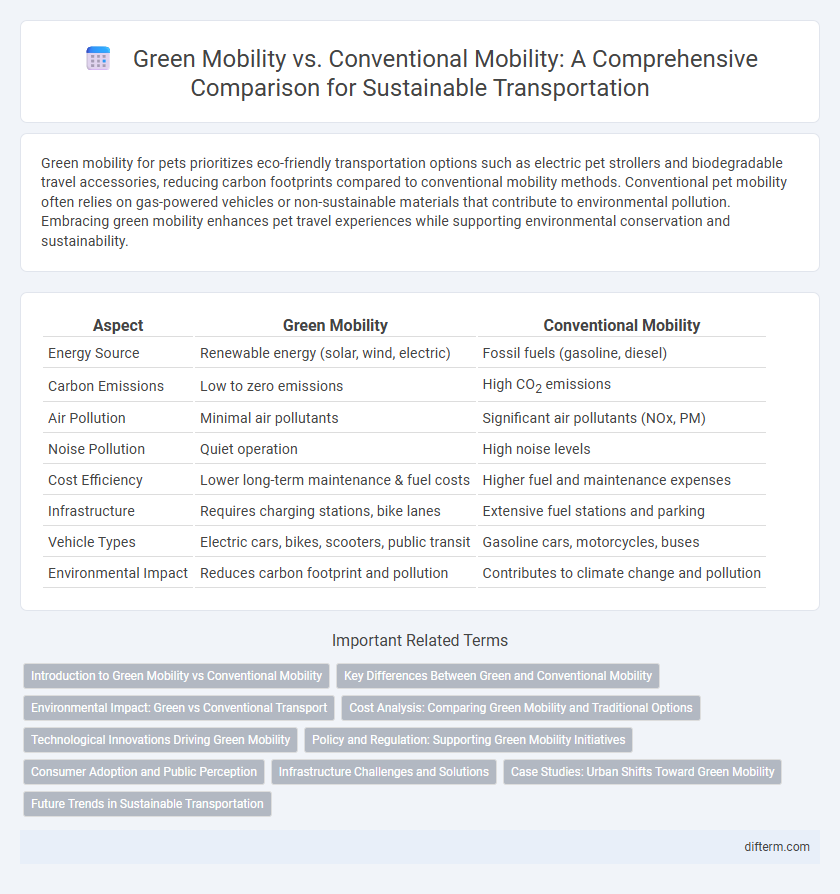Green mobility for pets prioritizes eco-friendly transportation options such as electric pet strollers and biodegradable travel accessories, reducing carbon footprints compared to conventional mobility methods. Conventional pet mobility often relies on gas-powered vehicles or non-sustainable materials that contribute to environmental pollution. Embracing green mobility enhances pet travel experiences while supporting environmental conservation and sustainability.
Table of Comparison
| Aspect | Green Mobility | Conventional Mobility |
|---|---|---|
| Energy Source | Renewable energy (solar, wind, electric) | Fossil fuels (gasoline, diesel) |
| Carbon Emissions | Low to zero emissions | High CO2 emissions |
| Air Pollution | Minimal air pollutants | Significant air pollutants (NOx, PM) |
| Noise Pollution | Quiet operation | High noise levels |
| Cost Efficiency | Lower long-term maintenance & fuel costs | Higher fuel and maintenance expenses |
| Infrastructure | Requires charging stations, bike lanes | Extensive fuel stations and parking |
| Vehicle Types | Electric cars, bikes, scooters, public transit | Gasoline cars, motorcycles, buses |
| Environmental Impact | Reduces carbon footprint and pollution | Contributes to climate change and pollution |
Introduction to Green Mobility vs Conventional Mobility
Green mobility prioritizes reducing carbon emissions through the use of electric vehicles, public transportation, cycling, and walking, promoting sustainable urban development and improved air quality. Conventional mobility relies heavily on fossil fuels, leading to higher greenhouse gas emissions, traffic congestion, and environmental pollution. Transitioning to green mobility solutions supports climate goals while enhancing energy efficiency and public health.
Key Differences Between Green and Conventional Mobility
Green mobility emphasizes electric and hybrid vehicles, reducing greenhouse gas emissions compared to conventional mobility reliant on internal combustion engines fueled by gasoline or diesel. Energy efficiency in green mobility is enhanced through renewable energy integration and sustainable transport infrastructure, whereas conventional mobility depends heavily on fossil fuel consumption and produces higher environmental pollution. Cost benefits of green mobility arise from lower operational and maintenance expenses, contrasting with the fluctuating fuel prices and higher environmental costs associated with traditional vehicle usage.
Environmental Impact: Green vs Conventional Transport
Green mobility significantly reduces greenhouse gas emissions compared to conventional transport by utilizing electric vehicles, bicycles, and public transit powered by renewable energy. Conventional transport relies heavily on fossil fuels, contributing to air pollution and climate change due to high carbon dioxide and particulate matter emissions. Transitioning to green mobility supports cleaner air, lowers carbon footprints, and promotes sustainable urban environments.
Cost Analysis: Comparing Green Mobility and Traditional Options
Green mobility solutions, such as electric vehicles and public transit, offer lower long-term operational costs due to reduced fuel expenses and maintenance requirements compared to conventional gasoline-powered vehicles. Initial investment for green technologies can be higher, but incentives, tax credits, and decreasing battery prices drive overall affordability. Lifecycle cost analysis reveals that green mobility not only reduces environmental impact but also provides significant financial benefits over time.
Technological Innovations Driving Green Mobility
Technological innovations such as electric vehicle (EV) advancements, battery improvements, and renewable energy integration are transforming green mobility by reducing carbon emissions and enhancing energy efficiency. Smart transportation systems leveraging IoT and AI optimize traffic management and promote eco-friendly transit options. These breakthroughs contrast sharply with conventional mobility, which relies heavily on fossil fuels and emits higher levels of pollutants, underscoring the shift toward sustainable transportation solutions.
Policy and Regulation: Supporting Green Mobility Initiatives
Policy and regulation play a crucial role in advancing green mobility by implementing stringent emissions standards and offering incentives for electric and low-emission vehicles. Governments worldwide are enacting frameworks that prioritize infrastructure development, such as charging stations and dedicated lanes, to support sustainable transportation modes. Regulatory measures also include subsidies and tax benefits aimed at accelerating the transition from conventional fossil fuel-based mobility to eco-friendly alternatives, thereby reducing urban air pollution and carbon footprints.
Consumer Adoption and Public Perception
Consumer adoption of green mobility solutions such as electric vehicles and shared transportation is accelerating due to growing environmental awareness and government incentives, while conventional mobility remains dominant in regions with limited infrastructure. Public perception favors green mobility for its sustainability benefits and cost savings over time, but concerns about range anxiety and charging availability hinder widespread acceptance. Market data shows a steady increase in electric vehicle sales correlating with improved battery technologies and expanding charging networks, indicating a gradual shift from traditional fossil fuel-powered transport.
Infrastructure Challenges and Solutions
Green mobility faces significant infrastructure challenges, including the need for widespread electric vehicle charging stations and enhanced public transit networks to reduce reliance on fossil fuels. Conventional mobility infrastructure, heavily invested in road expansions and fossil fuel refueling stations, requires retrofitting to accommodate electric vehicles and sustainable transportation modes. Solutions involve integrating smart grid technology, expanding renewable energy sources for transportation, and redesigning urban spaces to prioritize cycling, walking, and electric public transit systems.
Case Studies: Urban Shifts Toward Green Mobility
Urban areas implementing green mobility initiatives, such as Copenhagen's extensive bike-sharing system and Amsterdam's low-emission zones, demonstrate significant reductions in carbon emissions and traffic congestion. Case studies from cities like Curitiba highlight the benefits of Bus Rapid Transit (BRT) systems, which improve public transportation efficiency while lowering fossil fuel dependency. These shifts toward green mobility showcase measurable improvements in air quality, public health, and sustainable urban development compared to conventional car-centric models.
Future Trends in Sustainable Transportation
Green mobility technologies prioritize electric and hydrogen-powered vehicles, reducing carbon emissions and dependence on fossil fuels. Innovations such as advanced battery systems and smart grid integration are accelerating the transition from conventional gasoline and diesel transportation. Future trends emphasize urban air mobility, autonomous electric fleets, and expanded infrastructure for renewable energy charging stations to support sustainable transportation networks.
green mobility vs conventional mobility Infographic

 difterm.com
difterm.com